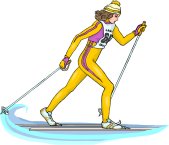
Worksheets and No Prep Teaching Resources
Reading Comprehension Worksheets
 Worksheets and No Prep Teaching Resources Reading Comprehension Worksheets |
|
| edHelper's suggested reading level: | grades 4 to 5 | |
| Flesch-Kincaid grade level: | 5.55 |
|
Olympic Cross-Country Skiing
By Trista L. Pollard |

|
 1 Since early times, people have traveled on ice and snow. The earliest skis found in Scandinavia were about 4,500 years old! People have used skis for transportation and work. Cross-country skiing or XC skiing was used by people to travel across large areas of snow. Even explorers used this type of Nordic skiing as transportation. The Scandinavian army still trains their soldiers in XC skiing.
1 Since early times, people have traveled on ice and snow. The earliest skis found in Scandinavia were about 4,500 years old! People have used skis for transportation and work. Cross-country skiing or XC skiing was used by people to travel across large areas of snow. Even explorers used this type of Nordic skiing as transportation. The Scandinavian army still trains their soldiers in XC skiing. |
Create Weekly Reading Books
Prepare for an entire week at once! |
| Leave your feedback on Olympic Cross-Country Skiing (use this link if you found an error in the story) |